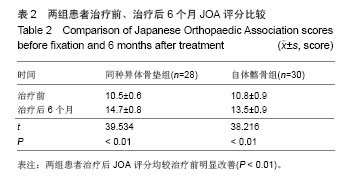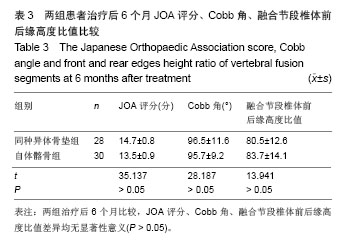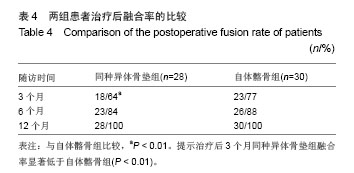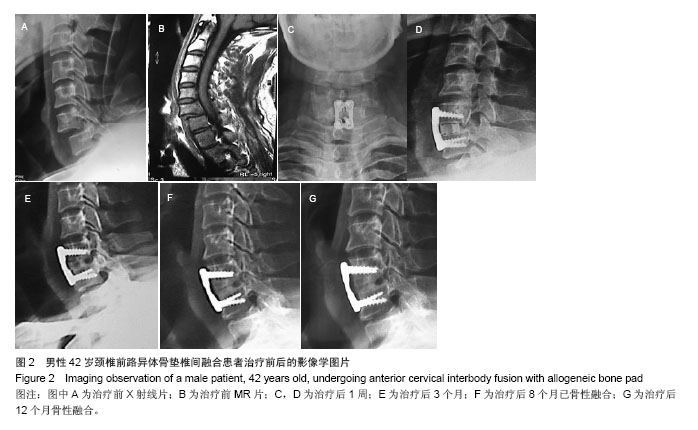| [1]林坚平,宋世锋,黎早敏,等.自体骨髓移植复合人工骨治疗骨缺损[J].中国组织工程研究与临床康复,2011,15(26): 4891- 4894.
[2]丛宪玲,王金成,王亮,等.骨库的特点及发展趋势[J].中国组织工程研究与临床康复,2011,15(33):6235-6338.
[3]关玉成,贾勇,粱景灏,等.自制异体骨垫在颈椎融合术中的临床应用[J].西北国防医学杂志,2010,31(1):17-18.
[4]Vail Jonbergen HP, Spmit M, Anderson PG, et al.Anterior cervical interbody fusion with a titanium box cage:early radio logical assessment of fusion and subsidence. Spine. 2005; 30:646-649.
[5]周其佳,王谦.同种异体骨移植在基层医院的应用研究[J].医学理论与实践,2007,20(12):1388-1390.
[6]Njoku I Jr, Alimi M, Leng LZ,et al.Anterior cervical discectomy and fusion with a zero-profile integrated plate and spacer device: a clinical and radiological study. Neurosurg Spine. 2014:1-9.
[7]Davis RJ, Kim KD, Hisey MS,et al.Cervical total disc replacement with the Mobi-C cervical artificial disc compared with anterior discectomy and fusion for treatment of 2-level symptomatic degenerative disc disease: a prospective, randomized, controlled multicenter clinical trial: clinical article. J Neurosurg Spine.2013;19(5):532-545.
[8]程昌志,林舟丹.同种异体骨移植在颈椎前路融合手术中的应用[J].中国组织工程研究与临床康复,2007,11(43):8765-8769.
[9]Kim CH, Chung CK, Jahng TA,et al. Segmental Kyphosis after Cervical Interbody Fusion with Stand-alone Polyetheretherketone (PEEK) Cages: A Comparative Study on Two Different PEEK Cages. Spinal Disord Tech. 2014. [Epub ahead of print]
[10]杨进顺,廖壮文,范子文,等.一体成型式皮质骨生物型颈椎椎间融合器在颈前路融合术中的应用[J].中华创伤骨科杂志, 2010, 12(7):609-612.
[11]Lan X, Xu JZ, Luo F,et al. One-stage debridement and bone grafting with internal fixation via posterior approach for treatment of children thoracic spine tuberculosis. Zhongguo Gu Shang. 2013;26(4):320-3
[12]Nayak AN, Stein MI, James CR,et al. Biomechanical analysis of an interbody cage with three integrated cancellous lag screws in a two-level cervical spine fusion construct: an in vitro study.Spine. 2014. pii: S1529-9430(14)00574-9.
[13]王宣,申勇,张英泽.脊柱非融合技术的新进展及应用[J].中国矫形外科杂志,2008,16(19):1486-1489.
[14]朱永顺,王文军.颈椎非融合性固定的研究进展[J].中国矫形外科杂志,2007,15(5):362-363.
[15]杨成林,毕郑钢,曹阳,等.椎间撑开颈前路减压植骨钢板内固定术治疗脊髓型颈椎病[J].中国矫形外科杂志,2007,15(5):328-330.
[16]Caroli E,Orlando ER,Andrea G,et al.Anterior cervical fusion with interbody titanium cage containing surgical bone site graft:our institution’s experience in 103 consecutive cases of degenerative spondylosis. Spinal Disord Tech. 2007;20(3): 216-220.
[17]Fraser JF,Hartl R. Anterior approaches to fusion of the cervical spine:a metaanalysis of fusion rates. Neuro surg Spine.2007; 6(4):298-303.
[18]毕大卫,祖罡,陈亿民,等.不同颈前路椎体间融合固定术疗效评价的病例对照研究[J].中国骨伤,2008,21(6):419-421.
[19]Davis RJ, Kim KD, Hisey MS,et al.Cervical total disc replacement with the Mobi-C cervical artificial disc compared with anterior discectomy and fusion for treatment of 2-level symptomatic degenerative disc disease: a prospective, randomized, controlled multicenter clinical trial: clinical article. J Neurosurg Spine.2013;19(5):532-545.
[20]Zigler JE, Delamarter R, Murrey D,et al.ProDisc-C and anterior cervical discectomy and fusion as surgical treatment for single-level cervical symptomatic degenerative disc disease: five-year results of a Food and Drug Administration study. Spine (Phila Pa 1976).2013;38(3):203-209.
[21]Fraser JF,Hartl R.Anterior approaches to fusion of the cervical spine: a metaanalysis of fusion rates. Neuro surg Spine. 2007; 6:298-303.
[22]Scholz M,Schnake KJ,Pingel A,et al.A new zero-profile implant for standalone anterior cervical interbody fusion.Clin Orthop Relat Res.2011;469:666-673.
[23]Miller LE,Block JE.Safety and effectiveness of bone allografts in anterior cervical discectomy and fusion surgery. Spine (Phila Pa 1976). 2011;36:2045-2050.
[24]Vanek P, Bradac O, DeLacy P, et al. Comparison of 3 fusion techniques in the treatment of the degenerative cervical spine disease. Is stand-alone autograft really the "gold standard?": prospective study with 2-year follow-up. Spine (Phila Pa 1976). 2012;37(19):1645-1651.
[25]Jacobs W, Willems PC, Kruyt M, et al. Systematic review of anterior interbody fusion techniques for single- and double-level cervical degenerative disc disease.Spine (Phila Pa 1976). 2011;36(14):E950-960.
[26]Jacobs W, Willems PC, van Limbeek J,et al. Single or double-level anterior interbody fusion techniques for cervical degenerative disc disease. Cochrane Database Syst Rev. 2011;(1):CD004958.
[27]Buttermann GR.Prospective nonrandomized comparison of an allograft with bone morphogenic protein versus an iliac-crest autograft in anterior cervical discectomy and fusion. Spine J.2008;8:426-435.
[28]Daentzer D,Willbold E,Kalla K,et al.Bioabsorbable Interbody Magnesium-Polymer-Cage: Degradation Kinetics, Biomechanical Stiffness and Histological Findings from an Ovine Cervical Spine Fusion Model.Spine (Phila Pa 1976). 2014. [Epub ahead of print]
[29]Matz PG,Anderson PA,Holly LT,et al.The natural history of cervical spondylotic myelopathy.J Neuro Surg Spine.2009;11: 104-111.
[30]Yan D,Wang Z,Deng S,et al.Anterior corpectomy and reconstruction with titanium mesh cage and dynamic cervical plate for cervical spondylotic myelopathy in elderly osteoporosis patients.Arch Orthop Trauma Surg. 2011;131: 1369-1374.
[31]Amaral SH,Silva MN,Giraldi M,et al.Multiple cervical arcocristectomies for the treatment of cervical spondylotic myelopathy: surgical technique and results. J Neurosurg Spine. 2007;7:503-508.
[32]Hwang SL,Lee KS,Su YF,et al.Anterior corpectomy with iliac bone fusion or discectomy with interbody titanium cage fusion for multilevel cervical degenerated disc disease.J Spinal Disord Tech.2007;20:565-570.
[33]Azab W,Abdel-Razek M,Ali A,et al.Outcome evaluation of a zero profile implant for anterior cervical diskectomy with fusion. Turk Neuro surg.2012;22:611-617.
[34]Daentzer D, Floerkemeier T, Bartsch I,et al.Preliminary results in anterior cervical discectomy and fusion with an experimental bioabsorbable cage - clinical and radiological findings in an ovine animal model.Springerplus. 2013;2:418.
[35]Hussain M,Natarajan RN,Fayyazi AH,et al.Screw angulation affects bone-screw stresses and bone graft load sharing in anterior cervical corpectomy fusion with a rigid screw-plate construct: a finite element model study.Spine J. 2009;9: 1016-1023.
[36]Marawar S,Girardi FP,Sama AA,et al.National trends in anterior cervical fusion procedures.Spine (Phila Pa 1976). 2010;35:1454-459.
[37]Jiang SD,Jiang LS,Dai LY.Anterior cervical discectomy and fusion versus anterior cervical corpectomy and fusion for multilevel cervical spondylosis: a systematic review.Arch Orthop Trauma Surg.2012;132:155-161.
[38]Daniels AH,Riew D,Yoo JU,et al.Adverse events associated with anterior cervical spine surgery. Am Acad Orthop Surg. 2008;16:729-738.
[39]Yang B,Li H,Zhang T,et al.The incidence of adjacent segment degeneration after cervical disc arthroplasty (CDA): a meta analysis of randomized controlled trials. PLoS One. 2012;7: e35-32.
[40]Oppenlander ME, Bina R, Snyder LA,et al. Intravertebral polymethylmethacrylate augmentation of anterior cervical discectomy fusion and plating in the setting of osteoporosis. Spinal Disord Tech. 2014;27(3):185-188.
[41]Louie PK, Hassanzadeh H, Singh K.Epidemiologic trends in the utilization, demographics, and cost of bone morphogenetic protein in spinal fusions.Curr Rev Musculoskelet Med. 2014;7(3):177-181. |





.jpg)